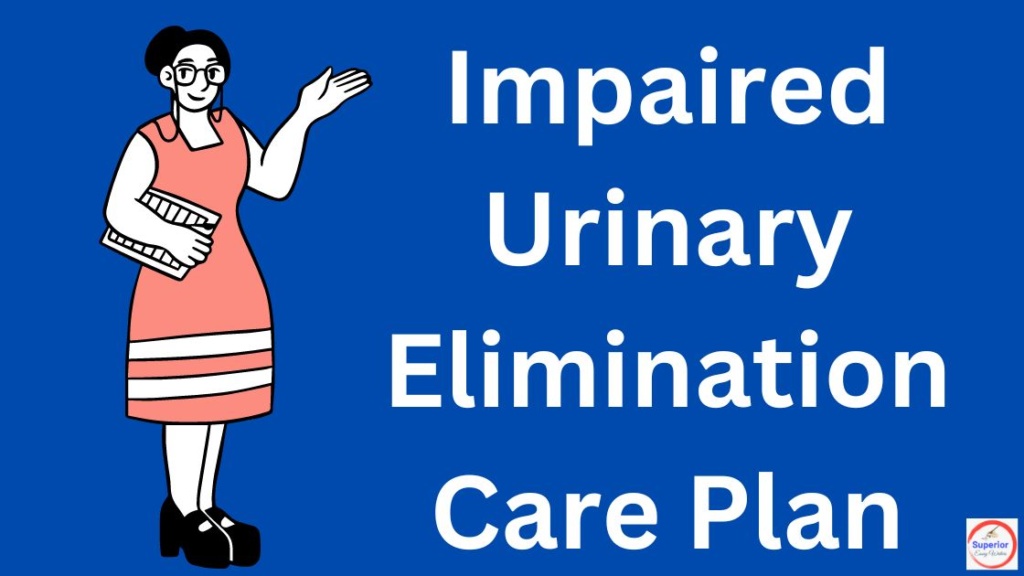
Impaired Urinary Elimination Care Plan
Care plans related to impaired urinary elimination are pertinent in nursing schools and the field; getting Impaired Urinary Elimination Care Plan and Nursing Diagnosis Writing Help is essential for students focused on success. Impaired urinary elimination nursing diagnosis refers to any primary disturbance during urine elimination. Nurses develop Nursing diagnosis impaired urinary elimination care plans for urinary tract infections (UTI) and other genitourinary disorders. Nursing diagnosis for impaired urinary elimination aims at creating a medical environment that allows patients to urinate without discomfort.
What is Impaired Urinary Elimination?
In most cases, impaired urinary elimination results from urine formation and discharge issues. NANDA nursing diagnosis related to impaired urinary elimination is a change in a urine elimination schedule. Practitioners look at stress urinary incontinence and other comorbidities to get information on nursing diagnosis related to impaired urinary elimination. The Impaired Urine Elimination care plan outlines all the actions required in the recovery. Nursing diagnosis risk for impaired urinary elimination is vital to ensure that all patients with risk factors are cared for. An excellent suggestion for the nursing care team is to get a reliable Impaired Urinary Elimination Care Plan and Nursing Diagnosis Writing Help. They can create excellent nursing care plans for regular patient follow-up with expert assistance.
Causes of Impaired Urinary Elimination
One of the most common causes of urinary incontinence is an abnormality or disease that affects bodily senses. Moreover, it is possible to suffer from bladder distention, painful urination, and full loss of bladder control. For this reason, treatment methods range from non-invasive therapy like bladder training to surgical procedures, depending on the underlying cause of incontinence. Albeit, surgery is conducted after completing impaired urinary elimination bladder surgery nursing diagnosis. Even if it’s annoying and frustrating, urinary incontinence can seriously impact one’s quality of life. Nurses can assist patients in determining the underlying causes of their symptoms and ways to minimize or eliminate them. Consequently, to develop a quality diagnosis, nurses should seek Impaired Urinary Elimination Care Plan and Nursing Diagnosis Writing Help. Needless to say, when they reach out to care plan writing services, they get expert help and guidance from seasoned nurses.
Creating Care Plans
From Impaired Urinary Elimination Care Plan and Nursing Diagnosis Writing Help, nurses can learn how to develop high-quality nursing diagnosis impaired urinary elimination related renal failure. Above all, our qualified tutors offer a NANDA nursing diagnosis for impaired urinary elimination due to diabetes. In most cases, students find it exceptionally hard to draft such care plans in line with NANDA requirements. Our Well curated writers also help clients develop a nursing diagnosis for AKI impaired urinary elimination. Creating such diagnoses is a cumbersome and arduous process. Equally important, seeking help and guidance ensures that you become well-versed on the subject, making life easier.
Our team of writers also aid in developing impaired urinary elimination related to epidural nursing diagnosis. During epidural administration for surgeries and other procedures, risks of UTI are high depending on the nurse’s skills. In line with epidural nursing, we also offer care plans related to impaired urinary elimination related to disc surgery nursing diagnosis. At the same time, we assist in developing impaired urinary elimination related to nursing diagnosis.
Nursing Assessment
What is the nursing diagnosis for impaired urinary elimination? The nurse must conduct a focus evaluation to determine whether incontinence is transitory. In other words, it may be due to an acute ailment or long-term due to various chronic neurological or genitourinary conditions. Nursing diagnosis for impaired urinary elimination related to UTI is vital in developing intervention measures for patients with urinary elimination issues. Nurses must also conduct a nursing diagnosis for impaired urinary elimination related to anesthesia after delivery. Such diagnoses are vital in creating goals and treatment modalities for the patients.
Steps of Developing Assessment
Step 1: Cause Identification
There are numerous causes of impaired urinary elimination; some of the basic causes include:
- UTIs, resulting in nursing diagnosis impaired urinary elimination r/t need for indwelling urethral catheter.
- Cystitis
- Multiple sclerosis
- Tetraplegia
- Stroke
Step 2: Voiding Pattern
To arrive at a diagnosis, consider the patient’s signs and symptoms. Insufficient urination and dribbling are symptoms of a prostate issue. UTIs are known to be frequent and painful when it comes to UTIs. Moreover, back and flank pain may indicate a kidney problem. NANDA nursing diagnosis impaired urinary elimination requirement is an important part of the nursing diagnosis.
Step 3: Lab work monitoring
A urinalysis and culture can help determine whether or not an infection is present. Diagnosing acute or chronic renal disease means having your kidney function evaluated. PSA blood test can detect inflammation in the prostate. For urethral surgeries, impaired urinary elimination bladder removal nursing diagnosis is essential for understanding the cause of the impairment.
Step 4: Medication Review
Certain medications have anticholinergic effects, making it difficult to urinate. Drugs that treat schizophrenia, bipolar disorder, and Parkinson’s disease are only a few examples. When drafting a nursing diagnosis for impaired urinary elimination related to renal failure, checking the patient’s medication is especially vital.
Step 5: Input and Output Comparison
The amount and type of fluid consumed should be compared to the amount and color of urine generated to determine hydration levels. NANDA nursing diagnosis impaired urinary elimination suggests the patient’s hourly urinary elimination assessment. A nursing diagnosis risk for impaired urinary elimination hydration fastens the results and fosters treatment.
Step 6: Catherization Issues
Occasionally, some patients with bladder impairment use self-catheterization or permanent suprapubic catheters. In order to avoid the introduction of microorganisms, make sure the catheterizations are performed correctly. Assess the necessity of indwelling catheters for patients who already have them. Catheterization issues are also crucial for nursing diagnosis for impaired urinary elimination related to UTI. There has been a rise in UTI infections due to catheterization within the healthcare industry.
Risk Factors for UTI
According to the NANDA nursing diagnosis for impaired urinary elimination, nurses must conduct simultaneous nursing diagnosis impaired urinary elimination UTI. This ensures that they identify all the related UTI risk factors and give the patient all the necessary remedies they need. Nursing diagnosis – impaired urinary elimination r/t need for indwelling urethral catheter NANDA is among the treatment procedures suggested for patients depending on their risk factors.
Abnormal Substances in Urine
It is possible to diagnose a problem based on abnormal urine not normally found in blood vessels. Examples include protein, glucose, and blood, which have different colors. From the urinary elimination impaired nursing diagnosis, nurses can identify foreign substances in the urine. These substances in nursing diagnosis risk for impaired urinary elimination assess patients at risk of developing the impairment. For nurses and students to successfully incorporate such critical components, they need to seek Impaired Urinary Elimination Care Plan and Nursing Diagnosis Writing Help.
Nursing Interventions
Bladder Training
Patients may benefit from regular exercise as a treatment for incontinence or an overactive bladder. A good place to start is having the patient keep a diary of when and how long it takes for the pee to come out. They then set a 15-minute interval and gradually increased it over several weeks or months. No matter how strong the urge is, patients should go to the restroom when instructed to do so. When drafting nursing diagnosis impaired urinary elimination, nurses should educate the patients on bladder training.
Foster Water Intake
As long as it’s safe for the patient to do so, encourage them to drink a lot of water. This may seem counterintuitive if the patient suffers from incontinence or an overactive bladder. However, dehydration has the opposite effect. Proper hydration aids in urine elimination by maintaining renal function and removing bacteria and waste materials. This step is crucial for nursing diagnosis for impaired urinary elimination related to renal failure.
Catheterization Demonstration
Patients who self-catheterize or use an indwelling or suprapubic catheter have a higher risk of infection. In order to ensure that the patient follows the correct procedures, such as washing the catheter daily with water and mild soap, and maintaining the drainage bag lower than the bladder’s level, pay attention as they perform cath-care. Demonstrations are especially important for nursing diagnosis impaired urinary elimination r/t need for indwelling urethral catheter.
Proper Hygiene
Females are susceptible to urinary tract infections than males due to the proximity of the anus to the urethra. Another key point, women should have instructions on wiping their hands from front to back after using the restroom and other prevention modalities. Such risk factors are essential while developing nursing diagnosis for impaired urinary elimination related to UTI.
Medication Education
As long as a doctor recommends it, medication can help alleviate bladder issues such as overactivity. Flomax works to unblock the bladder by relaxing the muscles of the bladder. By all means, blocking bladder contractions, Ditropan lowers the urge to pee. By seeking Impaired Urinary Elimination Care Plan and Nursing Diagnosis Writing Help, nurses and students can get helpful medication to recommend based on the patient’s status.
Nursing Intervention Goals
Patients with urinary incontinence will have a personalized treatment plan designed by a nurse. The treatment strategy should address the following goals and results:
- Seamless urination
- Minimal bladder distention during urination
- Incontinence identification cause
- Clear urine maintenance without odor
Hire an Expert
It may be difficult for the on-call nurse to formulate a clear nursing care plan. The upshot is that a growing number of nurses are turning to the internet to get help drafting an Impaired Urinary Elimination Care Plan. Our low-cost Nursing Care Plan Assignment Help is perfect for nurses and nursing students. With our nursing care plans, you’ll get a step-by-by-step approach to patient assessment and treatment that’s different from anything else out there. Seek Impaired Urinary Elimination Care Plan and Nursing Diagnosis Writing Help and get detailed diagnosis and care plans at reduced prices.

